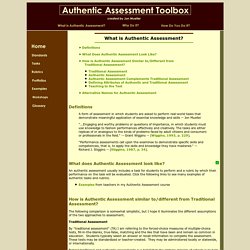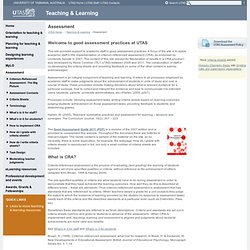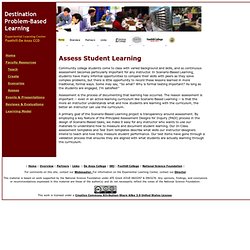

Outcomes Based Learning - Interviews. Outcomes Based Learning - Panel. Outcomes Based Learning - Introduction. What is Authentic Assessment? What is Authentic Assessment?

Definitions What Does Authentic Assessment Look Like? How is Authentic Assessment Similar to/Different from Traditional Assessment? Alternative Names for Authentic Assessment A form of assessment in which students are asked to perform real-world tasks that demonstrate meaningful application of essential knowledge and skills -- Jon Mueller "...Engaging and worthy problems or questions of importance, in which students must use knowledge to fashion performances effectively and creatively. The tasks are either replicas of or analogous to the kinds of problems faced by adult citizens and consumers or professionals in the field. " -- Grant Wiggins -- (Wiggins, 1993, p. 229). An authentic assessment usually includes a task for students to perform and a rubric by which their performance on the task will be evaluated.
Examples from teachers in my Authentic Assessment course 1. In the TA model, the curriculum drives assessment. 1. University Strategies. American Association for Higher Education ASSESSMENT FORUM 9 Principles of Good Practice for Assessing Student Learning The assessment of student learning begins with educational values.

Assessment is not an end in itself but a vehicle for educational improvement. Its effective practice, then, begins with and enacts a vision of the kinds of learning we most value for students and strive to help them achieve. Educational values should drive not only what we choose to assess but also how we do so. Authors: Alexander W. This document was developed under the auspices of the AAHE Assessment Forum with support from the Fund for the Improvement of Postsecondary Education with additional support for publication and dissemination from the Exxon Education Foundation. Assessment - Teaching & Learning - University of Tasmania, Australia. Welcome to good assessment practices at UTAS This site provides support to academic staff in good assessment practices.

A focus of the site is to assist academic staff in the implementation of criterion-referenced assessment (CRA), as endorsed by University Senate in 2007. The content of this site (except for 'Moderation of results in a CRA process') was developed by Moira Cordiner (TILT, UTAS) between 2009 and 2011. The collaboration of staff in co-developing the criteria sheets and providing feedback on some of the other content is warmly acknowledged. Assessment is an integral component of teaching and learning. Processes include: devising assessment tasks; writing criteria sheets based on learning outcomes; judging students' achievement on those assessment tasks; providing feedback to students; and determining grades. Harlen, W. (2005). The Good Assessment Guide 2011 (PDF) is a revision of the 2007 edition and is provided to complement this website. What is CRA? Brown, S. (1998).
Experiential Learning Center at De Anza College. Community college students come to class with varied background and skills, and so continuous assessment becomes particularly important for any instructor.

In Scenario-Based Learning, students have many informal opportunities to compare their skills with peers as they solve complex problems, but there is little opportunity to record these lessons learned in more traditional, formal ways. Some may say, "So what? Why is formal testing important? As long as the students are engaged, I'm satisfied! " Assessment is the process of documenting that learning has occurred. A primary goal of the Scenario-Based Learning project is transparency around assessment.